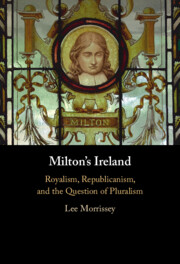Refine search
Actions for selected content:
60 results
Chapter 6 - Paradise Regained and the Rejection of the World
-
- Book:
- Milton's Strenuous Liberty
- Published online:
- 23 October 2025
- Print publication:
- 06 November 2025, pp 156-178
-
- Chapter
- Export citation
Chapter 4 - Milton and the Protectorate
-
- Book:
- Milton's Strenuous Liberty
- Published online:
- 23 October 2025
- Print publication:
- 06 November 2025, pp 101-125
-
- Chapter
- Export citation
Chapter 2 - Milton’s Anticlericalism, Part 2
-
- Book:
- Milton's Strenuous Liberty
- Published online:
- 23 October 2025
- Print publication:
- 06 November 2025, pp 56-85
-
- Chapter
- Export citation
Chapter 7 - The Political Messages of Samson Agonistes
-
- Book:
- Milton's Strenuous Liberty
- Published online:
- 23 October 2025
- Print publication:
- 06 November 2025, pp 179-205
-
- Chapter
- Export citation
Chapter 1 - Milton’s Anticlericalism, Part 1
-
- Book:
- Milton's Strenuous Liberty
- Published online:
- 23 October 2025
- Print publication:
- 06 November 2025, pp 34-55
-
- Chapter
- Export citation
Chapter 5 - How the Trouble Starts in Paradise Lost
-
- Book:
- Milton's Strenuous Liberty
- Published online:
- 23 October 2025
- Print publication:
- 06 November 2025, pp 126-155
-
- Chapter
- Export citation
Introduction
-
- Book:
- Milton's Strenuous Liberty
- Published online:
- 23 October 2025
- Print publication:
- 06 November 2025, pp 1-33
-
- Chapter
- Export citation
Chapter 3 - How Milton Defined Heresy and Why
-
- Book:
- Milton's Strenuous Liberty
- Published online:
- 23 October 2025
- Print publication:
- 06 November 2025, pp 86-100
-
- Chapter
- Export citation

Milton's Strenuous Liberty
-
- Published online:
- 23 October 2025
- Print publication:
- 06 November 2025
Chapter 6 - Metasecurity Dilemmas in John Milton’s Late Poems
-
- Book:
- Security, Fiscal Policy, and Sovereignty in Renaissance English Literature
- Published online:
- 04 September 2025
- Print publication:
- 18 September 2025, pp 161-202
-
- Chapter
- Export citation
Chapter 2 - The Lexicon of Print
-
- Book:
- How the World Became a Book in Shakespeare's England
- Published online:
- 09 August 2025
- Print publication:
- 14 August 2025, pp 32-72
-
- Chapter
- Export citation
Chapter 9 - English Literature to 1792
- from Part II - Intellectual, Cultural, and Political Contexts
-
-
- Book:
- Percy Shelley in Context
- Published online:
- 17 April 2025
- Print publication:
- 24 April 2025, pp 67-73
-
- Chapter
- Export citation
Chapter 30 - Ode
- from Part VI - Form, Genre, and Poetics
-
-
- Book:
- Gerard Manley Hopkins in Context
- Published online:
- 16 January 2025
- Print publication:
- 16 January 2025, pp 261-267
-
- Chapter
- Export citation
Chapter 31 - Sonnet
- from Part VI - Form, Genre, and Poetics
-
-
- Book:
- Gerard Manley Hopkins in Context
- Published online:
- 16 January 2025
- Print publication:
- 16 January 2025, pp 268-275
-
- Chapter
- Export citation
Chapter 3 - Early 1649
-
- Book:
- Milton's Ireland
- Published online:
- 14 November 2024
- Print publication:
- 12 December 2024, pp 81-103
-
- Chapter
- Export citation
Chapter 1 - 1641–1642
-
- Book:
- Milton's Ireland
- Published online:
- 14 November 2024
- Print publication:
- 12 December 2024, pp 30-57
-
- Chapter
- Export citation
Chapter 4 - Later 1649
-
- Book:
- Milton's Ireland
- Published online:
- 14 November 2024
- Print publication:
- 12 December 2024, pp 104-122
-
- Chapter
- Export citation
Chapter 2 - The 1645 Poems
-
- Book:
- Milton's Ireland
- Published online:
- 14 November 2024
- Print publication:
- 12 December 2024, pp 58-80
-
- Chapter
- Export citation
Chapter 5 - The Early 1650s
-
- Book:
- Milton's Ireland
- Published online:
- 14 November 2024
- Print publication:
- 12 December 2024, pp 123-144
-
- Chapter
- Export citation

Milton's Ireland
- Royalism, Republicanism, and the Question of Pluralism
-
- Published online:
- 14 November 2024
- Print publication:
- 12 December 2024
